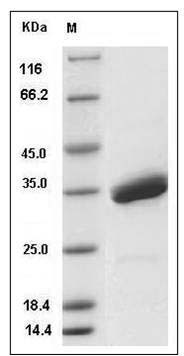-
Product Name
Mouse SPINK4 (Fc Tag) recombinant protein
- Documents
-
Description
Serine protease inhibitor Kazal-type 4, also known as Peptide PEC-60 homolog and SPINK4, is a secreted protein which contains one Kazal-like domain. SPINK4 is a member of the SPINK protein family. The gene family of serine protease inhibitors of the Kazal type (SPINK) are functional and positional candidate genes for celiac disease (CD). SPINK1 plays an important role in protecting the pancreas against excessive trypsinogen activation. It is a potent natural inhibitor of pancreatic trypsin activity. SPINK1 mutations are associated with the development of acute and chronic pancreatitis and have been detected in all forms of chronic pancreatitis. SPINK2 functions as a trypsin/acrosin inhibitor and is synthesized mainly in the testis and seminal vesicle where its activity is engaged in fertility. The SPINK2 protein contains a typical Kazal domain composed by six cysteine residues forming three disulfide bridges. SPINK9 was identified in human skin. Its expression was strong in palmar epidermis, but not detectable or very low in non palmoplantar skin.
-
Protein name
Serine protease inhibitor Kazal-type 4
-
Protein short names
RP23-28I8.2; MPGC60; SPINK4; MGC133107; PEC-60
-
Uniprot ID
O35679
-
Gene Name
Spink4; Mpgc60
-
Source/Expression Host
Human Cells
-
Expression Plasmid/cDNA
A DNA sequence encoding the mouse SPINK4 (NP_035593.2) (Met 1-Cys 86) was fused with the Fc region of human IgG1 at the C-terminus.
-
Protein Species
Mouse
-
Molecular weight
The secreted recombinant mouse SPINK4/Fc is a disulfide-linked homodimer. The reduced monomer comprises 301 amino acids and has a calculated molecular mass of 34.5 kDa. The apparent molecular mass of the monomer is approximately 35 kDa in SDS-PAGE under reducing conditions.
-
Purity
> 97 % as determined by SDS-PAGE
-
Validations

Mouse SPINK4 Protein (Fc Tag) SDS-PAGE
Related Products / Services
Please note: All products are "FOR RESEARCH USE ONLY AND ARE NOT INTENDED FOR DIAGNOSTIC OR THERAPEUTIC USE"
